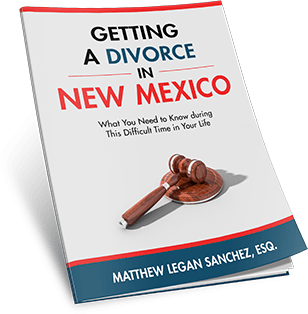
Understanding the complexities of dividing retirement accounts during a New Mexico divorce can be a daunting task.
In New Mexico, retirement accounts are considered part of the marital property and are subject to division between spouses. However, the process can be intricate, involving the identification, valuation, and allocation of these accounts.
This article, Sanchez Legal team dives into the nuances of retirement account division in New Mexico divorces. In doing so, we’ll provide key insights and guidance on dividing retirement during divorce.
Readers will better understand the different types of retirement accounts, such as 401(k)s and IRAs. Next, we’ll explore legal approaches for dividing retirement account during a New Mexico divorce.
Also, this article explores the various options available to couples going through a divorce. These options include direct division, equalization, or using a Qualified Domestic Relations Order (QDRO) to divide retirement accounts during a New Mexico divorce.
OVERVIEW OF RETIREMENT DIVISION IN NEW MEXICO DIVORCES
Dividing retirement accounts during a divorce in New Mexico is a critical aspect of the asset distribution process. In New Mexico, assets acquired during the marriage, including retirement accounts, are presumed to be community property. This means they are subject to equitable distribution between the spouses upon divorce.
However, the intricacies of this division can be complicated. You see, factors such as the type of retirement account, its value, and how it will be divided can complicate matters.
Understanding the process begins with recognizing that not all retirement accounts are treated equally under New Mexico law. Some accounts may have different policies regarding withdrawals and distributions, which can impact how they are divided. Moreover, the timing of the divorce and the contributions made to these accounts during the marriage can significantly influence the outcome.
So, it’s essential to approach asset division with a well-informed strategy to ensure fairness for both parties.
Additionally, the division of retirement accounts can significantly affect long-term financial security. A thorough analysis of each account’s current value, growth potential, and associated fees is necessary. This careful evaluation can help divorcing spouses make informed decisions about how to proceed. In doing so, both parties leave the marriage with a fair share of the accumulated assets and a clearer path toward future financial stability.
UNDERSTANDING COMMUNITY PROPERTY LAWS IN NEW MEXICO
New Mexico operates under community property laws, which fundamentally shape how assets are divided during a divorce. Under these laws, any property acquired during the marriage is considered joint property, regardless of whose name is on the title or account. This includes not just tangible assets like homes and cars, but also financial assets such as bank accounts and retirement plans. Understanding this principle is crucial for anyone going through a divorce, as it determines what is subject to division.
In practice, community property laws mean that both spouses typically have an equal claim to retirement savings accrued during the marriage. This can include contributions made to accounts like 401(k)s, PERA, pensions, and IRAs.
However, it’s important to note that property owned prior to the marriage, as well as gifts and inheritances received by one spouse, are considered separate property and are not subject to division under these laws. This distinction can sometimes lead to disputes over what constitutes community versus separate property, highlighting the need for clear documentation and legal guidance.
Furthermore, the characterization of certain assets can become contentious, especially if one spouse has significantly more retirement savings than the other. To navigate these challenges effectively, having a clear understanding of community property laws is essential. This knowledge helps in negotiating a fair settlement that acknowledges each spouse’s contributions and needs, ultimately facilitating a smoother transition into post-divorce life.
Watch this video to better understand how community property and retirement accounts are divided during a divorce in Albuquerque, New Mexico.
TYPES OF RETIREMENT ACCOUNTS AND THEIR DIVISION IN NEW MEXICO DIVORCES
When considering the division of retirement accounts in a divorce, it’s essential to recognize the various types of accounts involved. The most common retirement accounts include 401(k) plans, traditional IRAs, Roth IRAs, and pensions/PERA. Each of these accounts has unique features, rules, and implications for division that must be considered.
For instance, 401(k) plans are typically employer-sponsored and may have specific provisions regarding distributions, while IRAs offer different tax advantages and withdrawal rules.
401(k) plans are often subject to employer rules regarding early withdrawal and might require a Qualified Domestic Relations Order (QDRO) for division. This court order is crucial as it allows the plan administrator to divide the account without incurring penalties.
On the other hand, most IRAs can be divided without the need for a QDRO. However, the tax implications of such a division must still be carefully evaluated. The distinction between traditional and Roth IRAs also affects tax liabilities, as contributions to Roth accounts are made with after-tax dollars. Conversely, traditional IRAs may be subject to taxes upon withdrawal.
PENSION RETIREMENT ACCOUNTS AND DIVORCE IN NEW MEXICO
Pensions present their own set of challenges, as they often involve complex calculations based on years of service and salary history. Dividing a pension, such as PERA, ERB, or TSP typically requires the use of a specialized legal approach to ensure that both parties receive a fair portion of the benefits.
Also, pensions present unique issues with beneficiaries and survivor benefits attached to the pension. In New Mexico, survivor benefits should be considered in valuing and distributing the community interest in the retirement plan.
So, with New Mexico pensions, it’s essential to understand the interplay between Options A, B, and C, which deal with beneficiaries and survivor benefits.
Also, New Mexico divorce law enables the nonworking spouse to receive their portion of pension benefits once the working spouse is eligible to receive benefits. In other words, New Mexico divorce law can prevent one spouse from working indefinitely to prevent the other spouse from receiving pension benefits. See Ruggles. In doing so, the nonworking spouse can receive their share of the pension benefits directly from the working spouse until the working spouse retires.
Understanding these different types of retirement accounts and their specific division rules is vital for anyone navigating a divorce in New Mexico.
OPTIONS FOR DIVIDING RETIREMENT ACCOUNTS IN ALBUQUERQUE DIVORCES
When it comes to dividing retirement accounts in New Mexico divorces, there are several options available to spouses. One common approach is direct division, where the retirement account is split between the two parties. This can be done through a QDRO, which provides the legal framework for dividing accounts such as 401(k)s and pensions. A QDRO allows the non-employee spouse to receive a portion of the retirement benefits without incurring penalties, ensuring that they can access their share while keeping the account intact for the employee spouse.
Another option is an offsetting, where one spouse retains full ownership of a retirement account while the other receives a larger share of other marital assets, such as real estate or savings accounts. Offsetting can simplify the division process by allowing one party to keep the retirement account intact, while the other spouse receives compensation through other means. For instance, one spouse could keep their entire retirement, but agree to equalize the community portion by giving the other spouse a larger share of the home equity.
However, it requires careful valuation of all assets to ensure that the overall division remains equitable through offsetting. This is especially true if there are substantial differences in the value of the retirement accounts involved.
Couples may also consider a combination of both direct division and offsetting, tailoring the division strategy to their unique circumstances. This flexible approach can allow for a more amicable resolution, as it acknowledges the needs and priorities of both parties. Ultimately, the key to a successful division of retirement accounts lies in clear communication. This communication occurs thorough documentation, and a willingness to explore various options that meet both spouses’ financial needs.
QDROS (QUALIFIED DOMESTIC RELATIONS ORDERS) AND RETIREMENT ACCOUNT DIVISION
A Qualified Domestic Relations Order (QDRO) plays a pivotal role in the division of retirement accounts during a divorce in New Mexico. This legal document is essential for dividing certain types of retirement plans, such as 401(k)s and pensions, in a way that complies with federal regulations. The QDRO specifies the amount or percentage of the retirement benefit to be paid to the non-employee spouse. The QDRO ensures that each spouse receives their fair share.
The process of obtaining a QDRO can be intricate, often requiring the expertise of legal professionals familiar with retirement plan regulations and divorce law. It is crucial for the QDRO to be drafted correctly, as any errors or omissions can result in delays or complications in the distribution process. Once approved by the court, the QDRO must then be submitted to the plan administrator, who will implement the division in accordance with the order. This step is essential to ensure that the non-employee spouse receives their designated share directly from the retirement account.
It’s important to note that not all retirement accounts require a QDRO for division. Individual Retirement Accounts (IRAs), for example, can be divided through a simple transfer process without the need for this specialized order. However, understanding when a QDRO is necessary and how to navigate its complexities is vital for anyone facing the division of retirement accounts in a New Mexico divorce.
Working with knowledgeable legal and financial professionals can help ensure that the QDRO process is handled smoothly, protecting the interests of both parties in the divorce.
THE IMPORTANCE OF WORKING WITH A TOP DIVORCE ATTORNEY IN NEW MEXICO
Navigating the division of retirement accounts during a divorce can be challenging. So, it is essential to work with qualified financial professionals and attorneys.
Financial professionals can offer insights into the valuation of retirement accounts, helping to assess their current worth and future growth potential. This assessment is crucial for making informed decisions about how to divide these assets. They can also provide strategies for offsetting retirement accounts with other assets, ensuring that both spouses achieve a fair and balanced outcome. By collaborating with a financial advisor, individuals can develop a clear understanding of their financial situation post-divorce, allowing for better planning and decision-making.
Moreover, having a knowledgeable attorney can facilitate communication between both parties, potentially reducing conflict and promoting a more amicable divorce process. They can help draft necessary legal documents, such as QDROs, and ensure compliance with all relevant laws and regulations.
COMMON MISTAKES TO AVOID WHEN DIVIDING RETIREMENT ACCOUNTS IN A DIVORCE
Dividing retirement accounts in a divorce can be fraught with pitfalls. So, avoiding common mistakes is essential to ensure a fair outcome. One of the most significant errors individuals make is underestimating the value of retirement accounts. It’s crucial to conduct a thorough assessment of the current value and future growth potential of these accounts. Failing to accurately value retirement assets can lead to an inequitable division, ultimately impacting one spouse’s financial security in the long run.
Another common mistake is neglecting to consider the tax implications of retirement account division. Different types of retirement accounts have varying tax consequences associated with withdrawals and distributions. For instance, withdrawing funds from a traditional IRA may incur taxes, while Roth IRA distributions are tax-free if certain conditions are met. It’s essential to understand these nuances and how they will affect each party’s financial situation after the divorce. Consulting with a qualified tax professional can help clarify these implications and guide individuals in making informed decisions.
Additionally, many individuals overlook the importance of having a clear and legally binding agreement regarding the division of retirement accounts. Relying on verbal agreements or informal arrangements can lead to disputes and complications down the line. It is vital to ensure that all agreements are documented and approved by the court to avoid misunderstandings and protect both parties’ rights. By being aware of these common mistakes and taking proactive steps to avoid them, individuals can navigate the division of retirement accounts more effectively, ensuring a fair and equitable outcome.
ENSURING FAIRNESS AND FINANCIAL SECURITY THROUGH PROPERTY RETIREMENT ACCOUNT DIVISION IN DIVORCES
Navigating the division of retirement accounts in a divorce is a complex process that requires careful consideration and planning. In New Mexico, community property laws govern the distribution of assets such as retirement accounts. So, understanding the nuances of retirement account division is vital for ensuring fairness. By recognizing the different types of retirement accounts, the implications of QDROs, and the various options for division, individuals can work towards a resolution that meets the needs of both parties.
Moreover, avoiding common pitfalls and understanding the tax implications of retirement account division can significantly impact long-term financial security. Working with qualified financial professionals and attorneys can provide invaluable support, ensuring that individuals make informed decisions throughout the process. By prioritizing effective communication and a collaborative approach, couples can navigate this challenging time with greater ease, ultimately achieving a fair and equitable outcome.
In conclusion, ensuring financial fairness during a divorce involves careful planning and a comprehensive understanding of retirement account division. By taking the necessary steps to protect their interests and collaborating with professionals, individuals can pave the way for a more secure financial future post-divorce, allowing them to move forward with confidence.
Do you have a retirement account that needs to be divided during your divorce in New Mexico? If so, do you have an agreement on how the accounts will be split?
Call (505) SANCHEZ and speak with Albuquerque’s best uncontested divorce attorney.
On the other hand, do you have a contentious and contested divorce in Albuquerque, NM? Does your divorce involve a restraining order, or child custody issues such as kinship guardianship disputes?
In either scenario, our top-rated Albuquerque divorce attorneys are here to help. Call (505) SANCHEZ and talk with one of Albuquerque’s best family lawyers.








